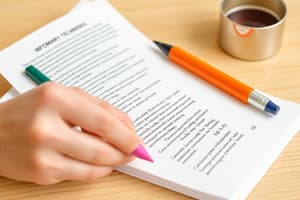Podcast
Questions and Answers
What is the primary purpose of the cue column in the Cornell Method?
What is the primary purpose of the cue column in the Cornell Method?
- To create an outline
- To take notes
- To review material
- To record keywords and summaries (correct)
The SQ3R method involves creating charts and diagrams.
The SQ3R method involves creating charts and diagrams.
False (B)
What is the main idea behind the Mind Mapping technique?
What is the main idea behind the Mind Mapping technique?
To create a visual representation of ideas and connections
The Outline Method uses ______________________ to denote main ideas, subtopics, and supporting details.
The Outline Method uses ______________________ to denote main ideas, subtopics, and supporting details.
Which method involves using abbreviations, symbols, and acronyms to record information quickly?
Which method involves using abbreviations, symbols, and acronyms to record information quickly?
The Charting Method is used to create a hierarchical structure of notes.
The Charting Method is used to create a hierarchical structure of notes.
Match the following summary techniques with their descriptions:
Match the following summary techniques with their descriptions:
What is the final step in the SQ3R method?
What is the final step in the SQ3R method?
Flashcards are hidden until you start studying
Study Notes
Summary Techniques
1. Cornell Method
- Divide paper into two columns: cue column (narrow) and note-taking column (wide)
- Record keywords, questions, and summaries in cue column
- Take notes in note-taking column, using headings, subheadings, and bullet points
- Review by covering note-taking column and recalling information from cue column
2. Outline Method
- Organize notes in a hierarchical structure using headings and subheadings
- Use Roman numerals, capital letters, and Arabic numerals to denote main ideas, subtopics, and supporting details
- Review by reading headings and subheadings to recall main ideas and supporting details
3. Mind Mapping
- Start with a central idea or concept
- Use keywords, phrases, and images to create branches and connections
- Review by tracing connections and recalling relationships between ideas
4. Charting Method
- Organize notes into charts, diagrams, and tables
- Use visual representations to illustrate relationships between ideas
- Review by studying charts and diagrams to recall information
5. SQ3R Method
- Survey: quickly read through material to identify main ideas and supporting details
- Question: turn headings and subheadings into questions
- Read: read material while looking for answers to questions
- Recite: summarize answers in own words
- Review: review summaries and questions to recall information
6. Shorthand Method
- Use abbreviations, symbols, and acronyms to record information quickly
- Review by translating shorthand notes into regular writing
- Note: requires practice to develop consistent shorthand system
Summary Techniques
Cornell Method
- The Cornell Method involves dividing paper into two columns: a narrow cue column and a wide note-taking column
- The cue column is used to record keywords, questions, and summaries
- The note-taking column is used for taking notes, with headings, subheadings, and bullet points
- This method enables reviewing by covering the note-taking column and recalling information from the cue column
Outline Method
- The Outline Method organizes notes in a hierarchical structure using headings and subheadings
- Roman numerals, capital letters, and Arabic numerals are used to denote main ideas, subtopics, and supporting details
- This method enables reviewing by reading headings and subheadings to recall main ideas and supporting details
Mind Mapping
- Mind Mapping starts with a central idea or concept
- Keywords, phrases, and images are used to create branches and connections
- Reviewing involves tracing connections and recalling relationships between ideas
Charting Method
- The Charting Method organizes notes into charts, diagrams, and tables
- Visual representations are used to illustrate relationships between ideas
- Reviewing involves studying charts and diagrams to recall information
SQ3R Method
- The SQ3R Method involves surveying material to identify main ideas and supporting details
- Headings and subheadings are turned into questions
- Material is read while looking for answers to questions
- Answers are summarized in own words, and summaries are reviewed to recall information
Shorthand Method
- The Shorthand Method uses abbreviations, symbols, and acronyms to record information quickly
- Notes are reviewed by translating shorthand into regular writing
- This method requires practice to develop a consistent shorthand system
Studying That Suits You
Use AI to generate personalized quizzes and flashcards to suit your learning preferences.




